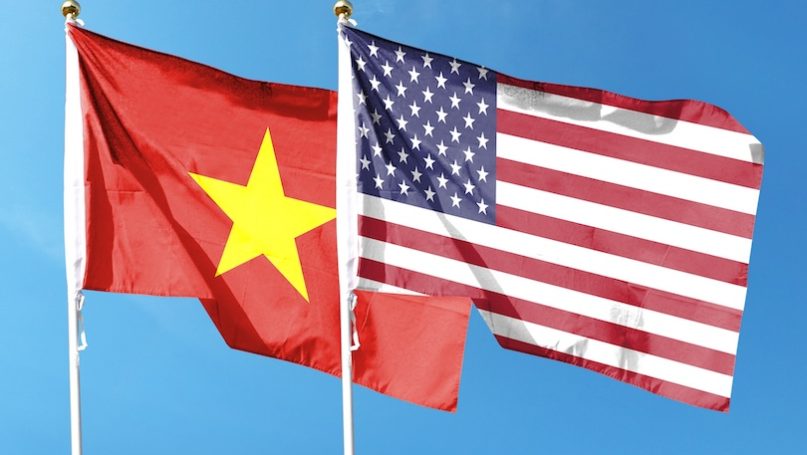
The United States and Vietnam, former adversaries but now significant trading partners, are in their second year of the comprehensive strategic partnership, further improving their ties. In 2025, the comprehensive strategic partnership makes a major two-year milestone as both America and Vietnam are thirty years into normalization, as five decades ago, both countries were intertwined in one of the most deadly wars in modern history. The comprehensive strategic partnership is a significant counterbalance in international relations in the Indo-Pacific region against China’s rising soft power and naval force projection into the South China Sea. In its second year, questions remain: Will the partnership hold up, and is there still room to grow between Washington and Hanoi?
On September 10th, 2023, then-U.S. President Joe Biden and the late General Secretary Nguyen Phu Trong of Vietnam signed the comprehensive strategic partnership, which is a major turning point in Southeast Asia. The elevation of relations between Hanoi and Washington puts America along the same bilateral status as Russia and China in Vietnam’s hierarchy, signifying a major diplomatic breakthrough between the former two countries.
Under the upgraded relations, Vietnam and the United States will further strengthen cooperation in trade, investments, science, technology, and climate action, with more opportunities in other sectors. Southeast Asia is an emerging global supply chain hub for not just the United States but the entire world, and Hanoi is a top ten major trading partner of Washington. The opportunity to grow supply chains in the Indochina region with Vietnam as a starting point would be an essential step toward digressing from the People’s Republic of China, which the United States government looks to do, especially as the latter two superpowers now compete for global hegemonic status.
The United States and Vietnam share the ideals of growing their technological and economic sectors. The growth of semiconductors in Eastern Asia continues to grow not only in Taiwan, China, Japan, and South Korea but also in Vietnam. Amkor, an American firm, is opening a $1.6 billion firm in Vietnam for this endeavor. Furthermore, Reuters reported in January 2024 that fifteen American firms are vying to invest $8 billion in semiconductors in Vietnam. American companies and business owners currently heavily invest in Vietnam, such as Intel, Apple, Nike, Amkor, Marvell, and First Solar, and the list can continue to grow in the comprehensive strategic partnership. Simultaneously, Vietnamese companies such as VinFast and VGN Corporation are increasing investments in the United States. VinFast’s growth in North Carolina is helping the local economy by creating more manufacturing opportunities.
Though Vietnam and the United States have reached new peaks in upgraded relations, it is vital to mention that the comprehensive strategic partnership is not a mutual defense accord including direct military assistance. During the joint signing, neither Washington nor Hanoi mentioned ‘containment’ of Beijing’s ambitions, even though the South China Sea continues to grow into a potential regional powder keg. Vietnam’s upgraded partnership with the United States correlates with India’s current strategy of not fully aligning to one side to trigger ire or retaliation from the People’s Republic of China but strategically keeping full diplomatic cohesion with all regional powers while maintaining its sovereignty.
Vietnam is also a close ally of Russia as the United States ignored the original requests for their self-determination post-WWII. Though they do not supply the Russian military’s illegal aggression in Ukraine, it is tantamount for the U.S. government not to push or strong-arm Hanoi closer to Moscow. Nevertheless, in the future, the U.S. and Vietnamese Armed Forces could establish backchannels to warn each other of any potential military threat by the People’s Liberation naval movements around the South China Sea without openly engaging in military cooperation that could draw strong actions from China and Russia.
Hanoi looks to advance its interests amidst rising economic and technological competition in the Indo-Pacific, and growing American investments will only push Vietnam’s marketing further. Simultaneously, Washington gains a growing economic and diplomatic presence in Southeast Asia. To promote a growing relationship, the United States can also further reconciliation efforts in the aftermath of the Vietnam War, as many of Vietnam’s demographic majority and elderly still remember the American aggression in the Indochina conflicts.
In its second year, Hanoi and Washington continue to grow ties through several key sectors that advance both country’s national interests and further open opportunities between the East and West. Rebuilding and rewriting the wrongs of the past, the United States reached out to Vietnam to solidify a comprehensive strategic partnership, which is decades in the making and a landmark agreement long envisioned by Ho Chi Minh. With opportunities to expand into the technology, economic, and trade sectors, Hanoi and Washington continue to grow bilateral ties in year two of the partnership.
Further Reading on E-International Relations
- Bamboo in the Wind: Vietnam’s Quest for Neutrality
- Opinion – Keeping Trade in Perspective in an Election Year
- Opinion – The Impact of an Indecisive America on the Indo-Pacific
- Opinion – Reassessing Military Misconceptions in the American-Japanese Alliance
- Opinion – The 2025 Philippine General Election and US Strategy in Asia
- The US in the Indo-Pacific: Leveraging India’s Period of Strategic Opportunity